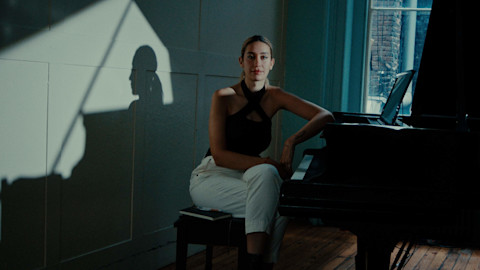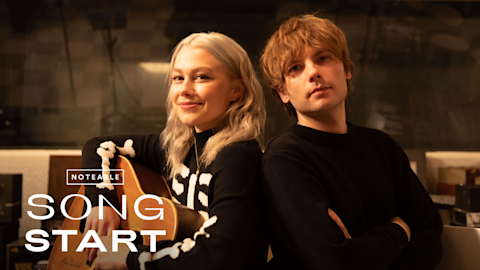Switched On Pop’s Nate Sloan, assistant professor of musicology at USC, shares what he’s learned through years of music analysis.
Nate Sloan—along with his partner in crime, songwriter Charlie Harding—hosts Vox’s Switched On Pop podcast, a show “about the making and meaning of popular music.” With a regular gig as assistant professor of musicology at the University of Southern California, Sloan’s not just a self-styled armchair expert on the matter. On the podcast, he and Harding explore the cultural and societal relevance of popular music and what makes it work the way it does—why do certain songs elicit specific reactions in listeners? Why does Taylor Swift’s “ME!” feel so instantly familiar? What are all the factors that had to come together to birth Lil Nas X’s “Old Town Road”?
We spoke with Sloan about the commonalities of hit tunes, and how certain songs are able to capture or define the cultural zeitgeist.
Spotify for Artists: After years of analyzing tunes, what have you noticed are some common elements of chart-toppers or songs that become global phenomena?
Nate Sloan: This may be applicable to the last, say, decade of songwriting—I think four-chord loops are one of the most surefire ways to see your song get some traction. I think a lot of the biggest hits of the past decade follow that formula, whether it's "Hello" by Adele or "Despacito" by Luis Fonsi. A four-chord loop usually includes some combination of major and minor triads is something listeners seem to really gravitate toward.
To dig a bit further, is there an attitude or a sound common to those most successful songs—happy, sad, upbeat?
I think actually people use these four-chord progressions to create what you might call a certain kind of harmonic ambiguity. It's unlike, say, the classical era where they were very interested in establishing a clear tonality. Now, popular music in the 21st century seems to be more inclined to sort of blur the harmonic edges and find the four-chord loop. "Despacito" or "Hello" are good examples. Neither of those firmly establish whether they're even in a major or a minor key. They keep you guessing by vacillating between major and minor. And that probably reinforces a similar sort of lyrical ambivalence in a lot of contemporary pop, where it's not explicitly sad or happy. It's exploring more of the emotional gray area.
I think it appeals to the most people and maybe reflects something about the—I don't know what the right word is—sort of ironic, post-truth culture we live in.
Another cool example might be Justin Bieber—his song "What Do You Mean?" also uses a four-chord loop that's suffused with ambiguity and uncertainty, but it's also one of the biggest hits of the last few years.
Charlie Harding and Nate Sloan
Can you think of recent examples where a pop song really broke that mold, where it was established that it was in a very specific mood but rose to the top of the charts anyway?
Maybe a song like "Fight Song" by Rachel Platten is in an unabashed major key, which really resonates with its message. You can't really have any ambiguity or doubt or uncertainty when the lyrics of your song are, “This is my fight song.” So that's certainly an example of a traditional sort of, “Here's a major key and here's my major message.” But I think we might increasingly see that to be less common. Even the biggest Number One hit right now, "Old Town Road," is in an ambiguous minor key, even though it has this message of confidence and braggadocio. So I think harmonic ambiguity in a four-chord loop is definitely something to exploit in this pop ecosystem.
Does that involve that one-six-four-five progression—the “ice cream changes progression”—you've mentioned in episodes of Switched on Pop?
Whenever that's used, whether it's in the Taylor Swift song "ME!" or going back to a song like "Heart and Soul" from the ’50s, that progression does convey a very clear harmonic center. But what you see more frequently now is a variation on that chord progression where you jumble up those four chords into a new order, and that's what you hear in "Despacito." Rather than one-six-four-five, you would hear six-four-one-five, I guess. By scrambling up the progression like, it's very familiar and used in a thousand different songs, but it doesn't have the same kind of harmonic clarity or tonal clarity that the ice cream changes progression might.
What do big, zeitgeisty songs most often tap into? Is it a feeling or a movement or a trend?
I think the biggest, most popular songs—and I feel like this is something kind of unchanged in pop music from over the last century—tap into some subtle gradient of what feels like a private emotional experience and turns it into something universal. So you're able to recognize the specificity of whatever the song is talking about while also feeling like it somehow applies to your life and the life of those around you.
Speaking of trends, what have you noticed are the qualities of the direction pop music is moving in recently?
I hear a lot of combining of acoustic and electronic sounds. Whether those “acoustic sounds” are actually acoustic or electronic in themselves is hard to hear sometimes. But suffice to say I think maybe for a while we were really interested in purely electronic music, and now I think our ears gravitate toward more of a kind of melding of acoustic and electronic sounds. So if you take a track like a SoundCloud rap hit like "Gucci Gang" by Lil Pump, that song is combining electronic trap drums with acoustic piano and that seems to be something that people find really appealing right now.
What are some ways that artists can ensure their music is of their time? How do they stay relevant?
I think the answer is that it's sort of an oxymoron, right? If you want to be of your time, don't try to be of your time. Simply by creating and responding to the world around you, you will create a sort of artifact of the moment where we're living. I think musicians at this moment are facing what the composer Igor Stravinsky once called “the abyss of freedom.” We have more musical history and global musical styles at our fingertips than ever before, and it can kind of be overwhelming. “What do I do with all these possibilities?” That's a daunting question. In a way it was simpler before—50 years ago, many people had never heard a sitar. Now you can not only hear one but you can conjure one in your laptop with the click of a button. What do we do with the overwhelming amount of musical options before us? To me, how musicians answer that question will define the sound of 2019.
—Matt Williams
Popular Stories
video
How Julia Wolf Made It




